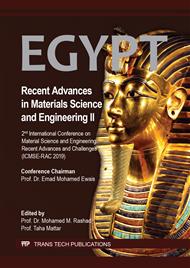p.123
p.130
p.135
p.141
p.149
p.155
p.163
p.171
p.178
LiMn1.5Ni0.25Fe0.2M0.05O4 Nanoparticles as a Cathode Material for Rechargeable Li-Ion Batteries
Abstract:
New series of spinel LiNi0.25Fe0.2Mˊ0.05Mn1.5O4 (Mˊ = Cu, Mg or Zn) cathode materials have been purposefully tailored using sol-gel auto-combustion method at low annealing temperature ~ 700°C for 3 h. The XRD analysis showed that all substituted (LNFMO-Mˊ) samples are comported with the main structure of undoped (LNFMO) with crystalline disordered spinel Fd-3m structure. TEM images revealed the octahedron-shape like morphology for the particles and the LNFMO-Zn sample has the widest particle size distribution. EIS spectra evidenced that a typical one semicircle (LNFMO-Mg) was revealed for each cell, suggesting the absence of ionic conductivity contribution. The values of charge transfer resistance (Rct) were equal to 9.3, 6.7, 6.0 and 4.4 kΩ for LNFMO, LNFMO-Cu, LNFMO-Mg indicating that the Zn-doped sample has the fastest kinetic diffusion rate and lowest activation energy of conduction.
Info:
Periodical:
Pages:
149-154
Citation:
Online since:
March 2020
Price:
Сopyright:
© 2020 Trans Tech Publications Ltd. All Rights Reserved
Share:
Citation:


